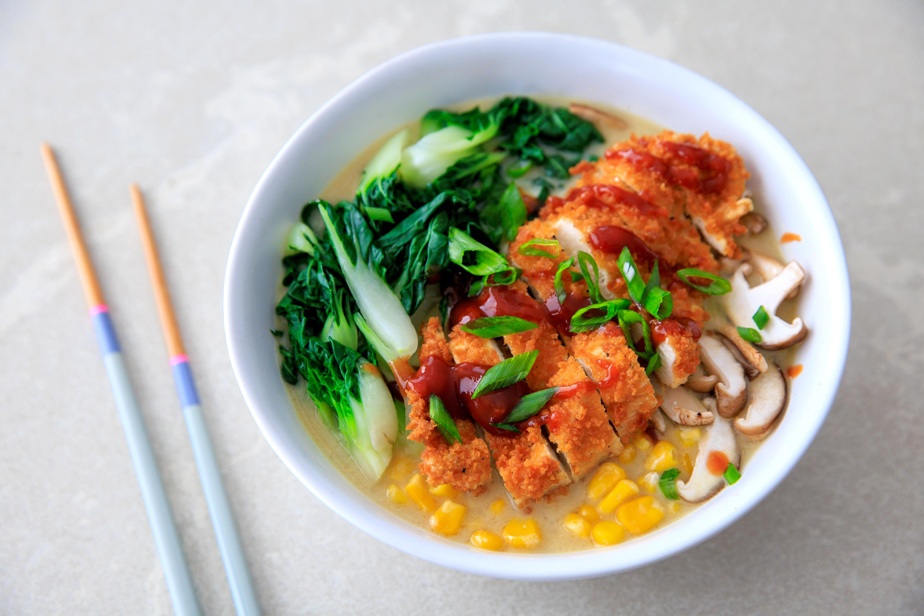Challenge met. It must be said, there are some mandates more inspiring than others. Let’s say that we didn’t have to be asked much to accept this project: learning how to cook ramen according to the rules of the art, from making the precious broth to assembling the bowl, including the choice toppings. Let’s dive!
We know that ramen counters have been gaining popularity in recent years. Montreal, which has dozens of good addresses, now even has its festival, Ramen Ramen, in the fall. Hubert Cormier smelled the seam when he noticed that the madness was not limited to the metropolis. From Quebec to Trois-Rivières, even in his family in Sept-Îles, everyone eats ramen noodles today!
He welcomes us into the bright kitchen of his house in Trois-Rivières, which also serves as an office and where he also has his photo studio. The nutrition doctor, multitasking communicator and prolific author, to whom we owe Bring me some ramen! (pun fully assumed, it goes without saying) last fall, loves cooking and it shows. He also likes to receive and work on his presentations nicely. And above all, he likes to eat.
Noodles for your health

PHOTO ALAIN ROBERGE, THE PRESS
Ramen is featured in Hubert Cormier’s most recent cookbook.
Moreover, we immediately dare to ask the question: isn’t it paradoxical for a nutrition expert to write a book on ramen, a priori not the healthiest dish there is to prepare? “In ‘ra-men’, he replies with the same smile that won’t let him go through the interview, ‘men’ means noodle! So it all depends on how you prepare these noodles! »
Let’s resolve the misunderstanding once and for all.
When we think of ramen, we think of a quick bag with a quick little seasoning. While it’s quite the opposite: it’s long [à préparer] !
Hubert Cormier, doctor of nutrition and author
You just have to leaf through his book (which has 85 recipes, including broths, sauces, soups and salads) to get a clear picture. Tonkotsu pork broth, one of the most popular, for example, must simmer for 12 hours – “It can take up to 24 hours! “. The same goes for chashu pork, this rolled pork belly filling that cooks for three hours and then leaves to cool for at least eight hours. Even soft-boiled eggs should ideally rest for 48 hours! So, no, we can’t say that ramen exactly qualifies as fast food, far from it. Which doesn’t mean it’s complicated, you’ll see.
Coming back to the health aspect of things, everything here also depends on the choice of noodles. From instant fried noodles to fresh homemade noodles, the range is wide, going from the least to the most healthy, we guess. For his part, Hubert Cormier opts for a non-fried instant ramen (on sale in all grocery stores), or for fresh noodles, sold in the frozen food counters of Asian grocery stores.

PHOTO ALAIN ROBERGE, THE PRESS
The choice of noodles is vast… and more or less “healthy”.
It all depends on the point of view, says our interlocutor: if you are looking for low sodium recipes, take your turn. “Yes, it’s high in sodium,” he concedes.
But it all depends on the vision. If for you, cooking at home is healthier because you control the ingredients, you can add vegetables, control the quantities, then yes, it’s healthy. It’s always in the eye of the beholder.
Hubert Cormier, doctor of nutrition and author
Or of the one who cooks, and especially of the one who tastes, one might add.
If you want to know everything, no, Hubert Cormier did not go to Japan to study the art of broth to write this book. But he ate plenty of them, here and there, between Toronto and Montreal, he says, while refusing to reveal his good addresses to us. And he doesn’t feel like an imposter. “I cook what I like,” he says, laughing. It may not be 100% traditional, but it’s close! »
And to see him easily prepare his dashi (basic broth, to which we owe the famous deep umami flavor so unique and so typical of ramen), and inhale the deliciously marine scent that emerges from it, we understand that he rather masters understand all the subtleties of the matter.
Visit the site Good for you, by Hubert Cormier

Bring me some ramen!
Saint-Jean Editor
193 pages
Did you know ?
This typical Japanese dish originally comes… from China! Ramen, which literally means “pulled noodles” (by hand), was even born in China in the 15th century.e century. At the end of the 19th centurye century, Japan began to import the famous noodles from its neighbor. The first soups, as we know them today, appeared in Tokyo at the beginning of the 20th century.e century, while restaurateurs quietly add pork belly, green onions, bamboo shoots and other garnishes, in addition to a broth. It was following the Second World War and the massive American wheat subsidy that the Japanese became truly infatuated with this comforting dish, a dish which, 50 years later, conquered the entire planet.
